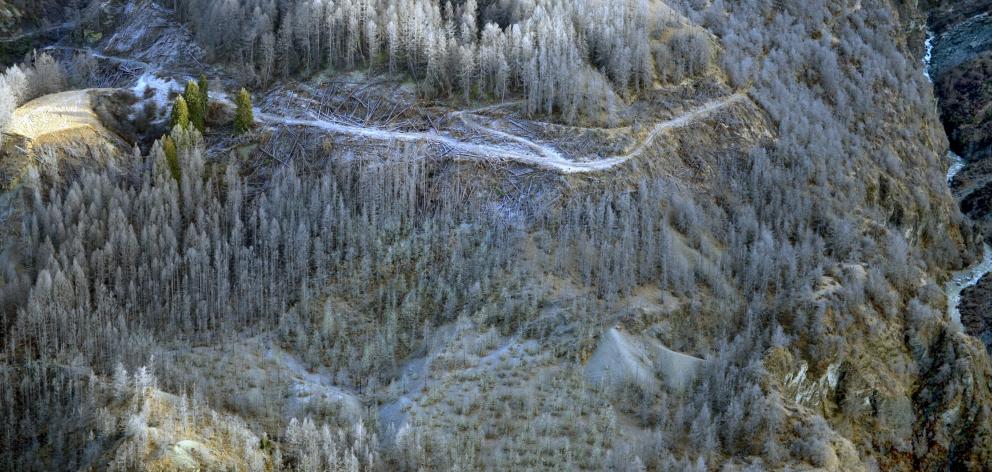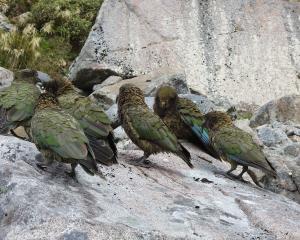
Clearance of indigenous vegetation, often in remote areas throughout New Zealand, for a range of reasons: farming, soil conservation, wood production, carbon capture, etc, has the potential to create a serious threat through the establishment of wildings many kilometres downwind, often into quite remote natural areas, through seed that are specialised for wind dispersal. Such wilding conifer problems are widespread in the South Island high country from Nelson-Marlborough, through Canterbury, as in the Mackenzie Basin, and the Wakatipu Basin in Otago, and also in Southland, as on Mid Dome and the Takitimu Mountains. Recognised as a national problem, a strategy is now in place and several million dollars are allocated annually to tackle this serious problem.
Currently, there are plantings of Douglas fir, known to pose one of the most serious wilding problems, close to the boundary of our most prestigious national park and world heritage area, Fiordland, where it borders the busy tourist highway accessing Milford Sound. Here there is ongoing, large-scale clearance of extensive stands of native manuka shrubland (now highly prized for its potential to produce valuable honey) for the planting of Douglas fir stands.
The potential for spread and serious wilding threat from these plantings must surely be obvious, including the beech forests and other vegetation in adjoining Fiordland National Park, based on its known tolerance of shade, as we have seen elsewhere in New Zealand and in its home range in the Rocky Mountains of the US.
Apparently Te Anau Downs property was granted a resource consent by Southland District Council, authorising clearance of some 300ha of native vegetation from a 425ha block of land, for the purpose of planting Douglas fir. This block is east of the Milford highway between Retford Stream and Dunton Creek. However, it appears that the clearance and planting has exceeded this area and now extends to the highway, and further clearance is currently under way to the west of the highway. The legality of this clearance needs confirming. Presumably the consent was granted in innocence and ignorance of the potential spread of Douglas fir, as was also the case with Glenfellen Station above Garston, where 190ha of Douglas fir was planted in upland tussock grassland (at the time, a consent was required from SDC only for plantings in excess of 200ha). Given its wilding potential, this planting was later cleared and the tussock cover retrieved, at considerable cost, by the Department of Conservation when it acquired the area through tenure review. And, as a result, the council amended its district plan to limit further such plantings. This lesson also clearly applies to Te Anau Downs.
Recently, the new Minister of Conservation Eugenie Sage, when visiting Milford, noted and expressed concern for this destruction, having seen it first hand. She responded: "I was dismayed to see massive destruction of manuka shrublands over hundreds of hectares on Southland’s Te Anau Downs Station. It’s an appalling sight on the road to Milford Sound/Piopiotahi, especially when the shrublands are feeding habitat for threatened long-tailed bats and many birds and insects. Such destruction of native habitat by private landowners is a major failure in RMA enforcement and causes biodiversity loss."
I am aware Te Anau residents have been taking photographs of this destruction and talking about the issue among themselves and expressing deep concern, but they aren’t speaking out publicly.
We have not been told publicly of any actions being taken on this issue by the Southland District Council / Environment Southland or the Department of Conservation, but if investigations are under way and it should transpire that there has been a failure to comply with legal requirements, enforcement should be urgently progressed and result in cessation notices and prosecution, if appropriate. There should also be information provided to the community by the relevant authority so the concerned public can understand what is happening.
Since Southland District Council’s new district plan came into effect in January 2018, the only legal clearance of indigenous vegetation, without a resource consent, is that which has regrown naturally on land that was lawfully cleared since 2000. Environment Southland is known to be concerned about wilding pines with its long involvement at Mid Dome (where I was a trustee for the first decade), and also with vegetation clearance of natural areas and subsequent exotic afforestation, with wilding potential, as expressed in its Southland Regional Policy Statement 2017. Under the new National Environmental Standards for Plantation Forestry, that came into effect in May this year, a wilding risk assessment must be done by a suitably competent person before any forestry trees are planted. If the risk assessment identifies any notable risks of wilding spread, permission to plant can be refused. Section 12 of the NES also states that "Afforestation must not occur within a significant natural area or an outstanding natural feature or landscape."
This surely must apply close to the boundary of Fiordland National Park.
- Sir Alan Mark is an Emeritus Professor at the University of Otago’s department of botany.












